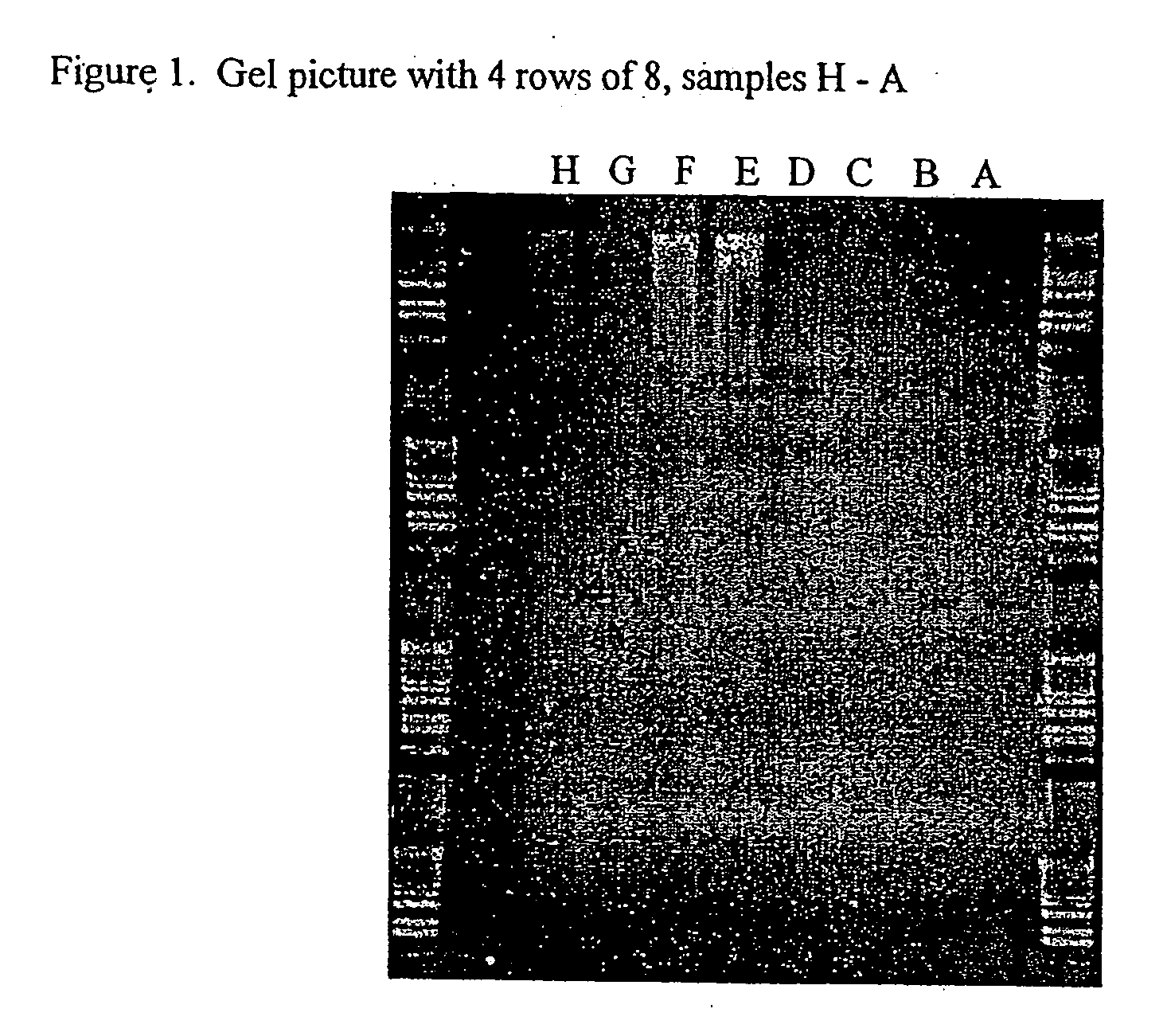Tagged polyfunctional reagents capble of reversibly binding target substances in a ph-dependent manner
a polyfunctional reagent and target substance technology, applied in the field of polyfunctional reagents, can solve the problems of nucleic acid release, and achieve the effects of facilitating detection, increasing the affinity of the interaction, and increasing the signal from the label
- Summary
- Abstract
- Description
- Claims
- Application Information
AI Technical Summary
Benefits of technology
Problems solved by technology
Method used
Image
Examples
example 1
[0116] A mouse monoclonal antibody raised against fluorescein isothiocyanate (FITC) was coated onto 300 ul wells of a polystyrene microtitre plate using 0.1M NaHCO3 at an antibody concentration of 4.6 ug / ml. After washing in 0.15M NaCl, the plates were ready to use.
[0117] To each row of wells DNA was added in a 50 mM potassium acetate buffer at pH4. Wells A-D contained DNA at 20 ug / ml, wells E-H contained DNA at 100 ug / ml. Uncoated wells were used as a control to detect non-specific binding. To every well, doubling dilutions of Poly Tris coupled to FITC were added and incubated for 1 hour at ambient. The Poly Tris polymer was prepared according to DRI patent applications U.S. Ser. No. 09 / 586,009 or WO 02 / 48164 then coupled to FITC in a 0.1M NaHCO3 buffer by mixing FITC with the Poly Tris at a ratio of approximately 1.25 mg to 5 mg respectively. Following dialysis, the conjugated polymer (PT-FITC) was ready to use.
[0118] In certain rows, the PolyTris-FITC conjugate was omitted to e...
example 2
[0120] This example employed biotin labelled poly Bis-Tris and streptavidin coated plates. Biotin labelled poly Bis-Tris was prepared by mixing Biotin with EDC and an excess of poly Bis-Tris. For example, 1 gram of poly Bis-Tris was mixed with 200 mg of biotin, 160 mg of EDC in 45 ml of 0.1M imidazole buffer pH6.5 to give approximate % wt ratios of biotin to PBT of 20%. Following an overnight incubation and exhaustive dialyis, the polymer was ready for use. The streptavidin coated plates were prepared by adding 300 ul of streptavidin at about 75 ug / ml in 0.1M NaHCO3 with 0.1% glutaldehyde to each well of a black polystyrene microtitre plate. After an overnight incubation, the plate was washed thoroughly with a saline solution and air dried.
[0121] To a series of wells, dilutions of the biotin-PBT was added in 10 mM Tris HCl pH8.5 and incubated for 3 hours. The plates washed in the same buffer and then treated with a DNA solution. A solution of calf thymus DNA was made up to 17 ug / ml...
example 3
[0124] This example used biotin labelled poly Bis-Tris and streptavidin coated Tip Plugs. A 30 um pore sintered plastic plug was coated with Streptavidin as described above by soaking the plugs for 2 days and then washing away any unbound material. The plug was then washed in a solution of 20% Biotin-PBT in 10 mM Tris-HCl pH8.5 by inserting the plug into a 1 ml pipette tip and pumping repeatedly. The unbound polymer was then washed away using the same buffer and the Tip Plug was ready for use.
[0125] To test the coated plug, 10 ug of Lambda DNA was added to 100 ul of serum with 1 ml of DRI lysis buffer (DRI part No. CO33) and 10 ul of proteinase K at 20 mg / ml. After an incubation period of 15 minutes with mixing, 100 ul of 1.6M potassium acetate and potassium chloride buffer pH4 was added and mixed. This solution was then pumped across the tip plug several times to bind the DNA. The plug was then washed with water and the DNA eluted with 200 ul of 10 mM Tris-HCl pH8.5 by pumping sev...
PUM
| Property | Measurement | Unit |
|---|---|---|
| pKa | aaaaa | aaaaa |
| pKa | aaaaa | aaaaa |
| pH | aaaaa | aaaaa |
Abstract
Description
Claims
Application Information
 Login to View More
Login to View More - R&D
- Intellectual Property
- Life Sciences
- Materials
- Tech Scout
- Unparalleled Data Quality
- Higher Quality Content
- 60% Fewer Hallucinations
Browse by: Latest US Patents, China's latest patents, Technical Efficacy Thesaurus, Application Domain, Technology Topic, Popular Technical Reports.
© 2025 PatSnap. All rights reserved.Legal|Privacy policy|Modern Slavery Act Transparency Statement|Sitemap|About US| Contact US: help@patsnap.com

